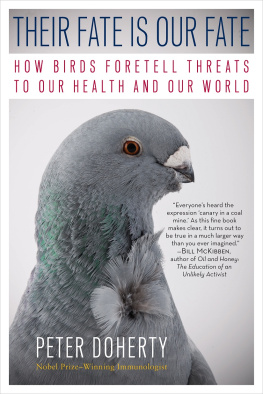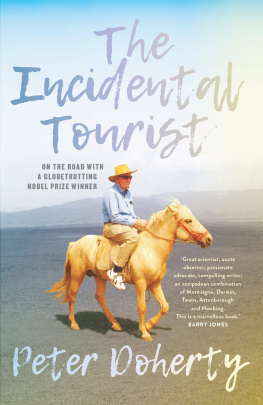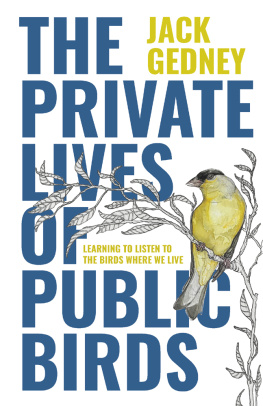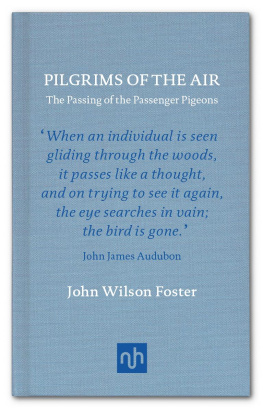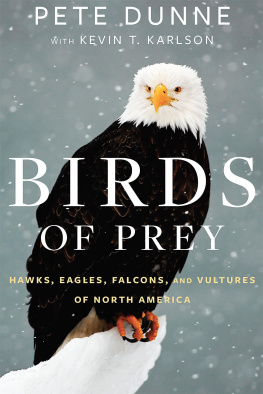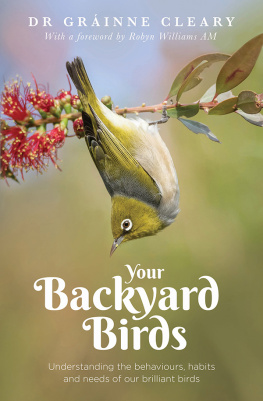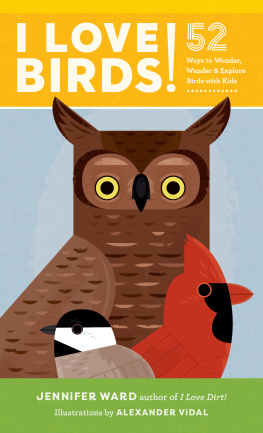ABOUT THE AUTHOR
PETER DOHERTY is Laureate Professor, Department of Micro-biology and Immunology, at the University of Melbourne, Australia, and Michael F. Tamer Chair for Biomedical Research at St. Jude Childrens Research Hospital, Memphis, TN. His pioneering research into immunity earned him the Nobel Prize for Physiology or Medicine in 1996, which he shared with Rolf M. Zinkernagel. The following year he was named Australian of the Year and a Companion of the Order of Australia.
Also by Peter Doherty
The Beginners Guide to Winning the Nobel Prize
A Light History of Hot Air
Pandemics: What Everyone Needs to Know
THEIR FATE IS OUR FATE
How Birds Foretell Threats to Our Health and Our World
Peter Doherty

New York
Their Fate Is Our Fate: How Birds Foretell Threats to Our Health and Our World
Copyright Peter Doherty, 2012, 2013
The are a continuation of this copyright page.
All rights reserved. Except for brief passages quoted in newspaper, magazine, radio, television, or online reviews, no portion of this book may be reproduced, distributed, or transmitted in any form or by any means, electronic or mechanical, including photocopying, recording, or information storage or retrieval system, without the prior written permission of the publisher.
An earlier version of this book was originally published by Melbourne University Publishing Limited, Australia, in 2012.
The Experiment, LLC
260 Fifth Avenue
New York, NY 100016408
www.theexperimentpublishing.com
The Experiments books are available at special discounts when purchased in bulk for premiums and sales promotions as well as for fundraising or educational use. For details, contact us at .
Many of the designations used by manufacturers and sellers to distinguish their products are claimed as trademarks. Where those designations appear in this book and The Experiment was aware of a trademark claim, the designations have been capitalized.
Library of Congress Cataloging-in-Publication Data
Doherty, P. C. (Peter C.)
Their fate is our fate : how birds foretell threats to our health and our world / Peter Doherty.
pages cm
An earlier version of this book was originally published by Melbourne University Publishing Limited, Australia, in 2012--Title page verso.
Includes bibliographical references and index.
ISBN 978-1-61519-091-1 (paperback) -- ISBN 978-1-61519-182-6 (ebook) 1. Birds--Behavior. 2. Birds--Diseases. 3. Birds--Ecology. 4. Public health--Forecasting. 5. Epidemiology--Forecasting. 6. Quality of life--Forecasting. 7. Environmental quality--Forecasting. 8. Indicators (Biology) 9. Environmental indicators. I. Title.
QL699.D64 2013
598--dc23
2013017159
ISBN 978-1-61519-091-1
Ebook ISBN 978-1-61519-182-6
Cover design by Christine Van Bree
Author photograph by Peter Doherty
Cover photograph of an English Owl, a breed of domestic pigeon, Columba livia Richard Bailey
Manufactured in the United States of America
Distributed by Workman Publishing Company, Inc.
Distributed simultaneously in Canada by Thomas Allen and Son Ltd.
First published September 2013
10 9 8 7 6 5 4 3 2 1
CONTENTS
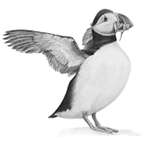
Searching for puffins: An introduction
WITH A BIT OF luck, this was to be the day we would finally meet the puffins. Eight days into our ten-day vacation trip, I still hadnt spotted one. And it wasnt as though theyd been driven away by crowds of other travellers. Our small, 80-passenger boat had been the first of the 2010 summer season to drop down through the Ballard Locks on our way from Seattles Lake Washington to Puget Sound, before heading north to the San Juan Islands and on past British Columbia to Alaska and our eventual disembarkation in Juneau. Wed pretty much had the protected Inside Passage waterway to ourselves.
With side trips to see glaciers and to visit small communities, it had all been a very enjoyable experience, at least for those whose idea of relaxation is to stand out on a sometimes freezing deck trying to spot wildlife. Every cabin was provided with two sets of powerful binoculars, but there was no guarantee that we would see all the species described in the guidebooks.
So far, though, the sightings of marine and land mammals had more than lived up to expectations. Wed progressively spotted seals, sea lions, orcas, humpback whales, Dalls porpoises, deer, mountain goats, and black and brown (grizzly) bears. Further north, we saw sea otters floating past on their backs with their heads and tails sticking up like black bookends in the current.
Early on, we had sighted a puffin relative, a rhinoceros auklet, and wed seen other alcids like murrelets and guillemots. Then there were cormorants, terns and gulls of various types. Having come late to bird spotting, much of this was both novel and intriguing. The discovery of a new interest as the years roll on is one of lifes good surprises. Of course, I could already recognise many of the familiar bird species. Bald eagles and ravens were everywhere along the Inside Passage. Parked watchfully in convenient locations, they wouldlike the ubiquitous commuter floatplanestake off to do loops and bumps along the waterfronts of human habitation. Out on the waterway, we tracked unmistakable white (piebald) eagle heads flying low and fast, while others poked from nests in the tall trees of unspoiled forests. Poised on a calved, floating iceblock, an eagle launched dramatically, then swooped to the glacial sea and soared again, a large fish tightly clasped in its talons.
The dominant, all-seeing eagle has been the symbol of temporal might from ancient Rome, through Byzantium and Czarist Russia to the present-day USA. Wharf-side at the Alaskan fishing port of Petersburg, I had stared, fascinated, at a full-grown eagle perched nearby on a tall post, and soon realised that I was being examined with at least equal intensity. Their binocular eyesight, along with a more sensitive retina and the capacity to see a broader spectrum of colours, gives eagles (and all birds of prey) extraordinarily visual acuity. He saw me much more clearly than I saw him. Still, its interesting that eagle symbolism is more about all-seeing power than about sanitation, given that the latter may well be the eagles most important function in nature. Earlier in our Alaskan voyage, wed watched through binoculars as a few ravens and a host of (largely immature) bald eagles had stripped the corpse of a beached, dead whale.
The iconic bald eagle is, of course, found only in North America. Ravens, on the other hand, are widely distributed across the planet and can be found in every part of the world in which Ive lived. In Alaska we were seeing Corvus corax, the same species as the famous ravens of the Tower of London, while our backyard in antipodean Australia is sometimes host to the little raven, Corvus mellori. (Ive mostly just used the common names of birds throughout this book, but a list of Latin binomials is provided at the end.)
Birds are powerful symbols. The indigenous people of this part of North America, the Tlingit, divide themselves into eagles and ravens. Wed seen and heard something of Tlingit culture in the community hall at Metlakatla, a small township that, like many on the Inside Passage, is only accessible by air or water. Traditionally, an eagle has to marry a raven, which is a pretty good way to prevent inbreeding and the genetic diseases that can follow. Eagles and ravens arent, though, the exclusive avian focus for the Tlingit. They also have a somewhat different, and more pragmatic, relationship with puffins. Taking advantage of available resources, the ancestral Tlingits harvested puffin colonies for meat, skins and eggs.
Next page
